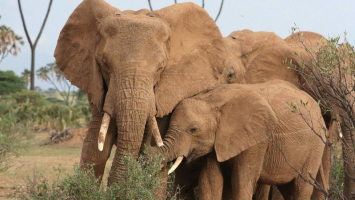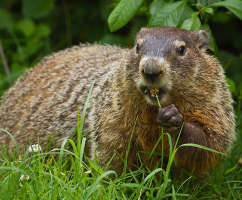Top 5 Predators of Aardvarks that Eat Aardvarks
The African continent is home to the aardvark, a burrowing animal. Together with elephants and manatees, it is regarded as an afrothere. Aardvarks, while being ... read more...a medium-sized species, live in harsh environments, making them vulnerable to being pursued by a variety of various predators. Here are the top predators of aardvarks that eat aardvarks.
-
Like many snakes, pythons are excellent opportunistic hunters. Many different creatures will be caught and killed by them, and pythons are especially likely to prey on aardvarks.
When it comes to catching its prey, this aardvark predator will employ a kind of ambush strategy. The aardvark will be pursued by them, and when it is asleep, they will ambush it. Pythons catch their prey with their razor-sharp, backward-curving teeth, which have two rows in the lower jaw and four rows in the upper. They then continue to murder the animal by wrapping their coil around its body and biting into it. Cardiovascular arrest is the main cause of death.
Pythons are extremely ambitious when it comes to the size of their prey, therefore regardless of size, they will try to kill an aardvark. They will gently devour the animal's entire corpse after killing it. Pythons often devour enormous creatures, therefore in certain circumstances they only need to feed a few times a year.
An aardvark may find it challenging to protect itself against a python in terms of defence. Aardvarks have incredibly powerful legs that may be helpful in fending off the python, and their thick skin may offer it some protection from the bite.

Photo: Wikipedia - Reticulated python 
Photo: Spiegel - Python -
The lion is among the most hazardous predators of aardvarks that eat aardvarks. Aardvarks are solitary and nocturnal creatures, and because of this, predators like lions may find them to be simple prey.
Large cat of the Panthera genus, the lion is indigenous to Africa and India. Due to its diverse range of food, the lion is a generalist hypercarnivore and is regarded as both an apex and keystone predator. Most of its prey are mammals. Its physique is broad-chested and strong, and it has round ears, a small, rounded head, and a hairy tuft at the end of its tail. It is a sociable animal that organizes into prides. Several adult males, associated females, and cubs make up a lion's pride. Female lions typically hunt in packs and target huge ungulates as their primary food. An apex and main predator is the lion. Although certain lions have been known to chase humans and scavenge when the opportunity arises, the species generally does not aggressively hunt and prey on humans.
Lions normally eat their food where they hunt, although they occasionally pull enormous animals into cover. They frequently argue over kills, especially the males. When food is in short supply, cubs suffer the most, but otherwise everyone in the pride eats to their heart's content, even elderly and disabled lions, who can survive on leftovers.
This aardvark predator will pursue an aardvark before catching it, tearing it up, and eating it. Despite having the appearance of being a timid and defenseless creature, the aardvark will make an effort to protect itself by using its razor-sharp claws, but it is unlikely to be able to repel a full-grown lion. If a young lion cub tries to devour it, it could have a chance to get away.

Photo: Wikipedia - Lion 
Photo: Chickgolden - Lions -
Big meat eaters, cheetahs can be particularly hazardous aardvark predators. Cheetahs have been known to consume aardvarks if the conditions are favorable, however they do prefer to eat animals like wildebeests, guineafowl, grey duikers, impalas, kudus, or gazelles.
In order to escape other predators, cheetahs often stalk their prey throughout the day. They hunt by using their keen eyes to spot their prey, and they frequently stalk it for a time before chasing it. Aardvarks have an edge over some of the other predators on this list since they do not utilize their noses to hunt. If a cheetah decides to pursue an aardvark, it will probably first stalk it for a short while before launching into a swift pursuit. Because of cheetahs' renown for speed, an aardvark stands little chance of ever evading them in a direct chase.
But because cheetahs can only sustain their full speed for a short time, this is the only opportunity an aardvark has to flee. Aardvarks, on the other hand, can dig swiftly, giving them another option for defending themselves from a cheetah.
Aardvarks also have extremely tough skin, which makes them less appealing as a food source in the wild because it is difficult for animals to chew on.

Photo: Live Science - Cheetahs 
Photo: The New York Times - Cheetah -
Like lions and cheetahs, leopards don't have especially specialized dietary preferences. The leopard is a lonely and possessive creature. When crossing streets and spotting approaching cars, it is usually wary and watchful, but if attacked, it may become brazen and turn on people or other animals. Adults exclusively interact during breeding season. Even after weaning, females engage with their young. When they are unable to catch any prey, they have been seen sharing kills with their young. They may vocalize in a variety of ways, including as growls, snarls, meows, and purrs. They eat a variety of creatures, including fish, birds, rodents, and even cheetahs.
The only drawback for an aardvark is that, like them, leopards are mostly nocturnal creatures, making them easy prey. The two creatures frequently come into contact with one another since leopards frequently hunt alone at night. Leopards often pursue their prey by crouching down, scouting it out, and then leaping out to bite its neck in a single swift motion. Even an aardvark with its thick skin finds it impossible to defend itself against a leopard's fangs, which are quite powerful. Leopards generally pull their prey once they have caught it, and they will frequently bring it up a tree with them. In order to protect it from other potential predators like lions and hyenas, they do this. Additionally, they will feed their kids from what they eat.

Photo: Wikipedia - Leopard 
Photo: BBC - Leopard -
One of the predators of aardvarks that eat aardvarks in North Africa is the African wild dog. The sole living member of the genus Lycaon, which differs from Canis by having a highly adapted dentition for a hypercarnivorous diet and by lacking dewclaws, it is the biggest wild dog in Africa. These creatures are opportunistic predators who love scavenging on larger prey like antelopes and warthogs, but they will also gladly slay an aardvark.
The African wild dog, like other canids, regurgitates food for its pups, but it also does it for adults as a crucial aspect of the social life of the pack. The young are permitted to consume corpses first. It has been revered in many hunter-gatherer communities, including those of the predynastic Egyptians and the San people, despite not being as well-known or famous in African mythology or culture as other African carnivores.
African wild dogs spend a lot of time in packs and are very gregarious creatures. They hunt in groups, making it exceedingly challenging for possible prey to flee from them. Once they've located their target, they'll circle it and attack it collectively, leaving the victim helpless. Aardvarks can dig extremely swiftly underground, which may provide them with a short escape, although it would seem doubtful that they would do so if they were already being encircled.

Photo: AZ Animals - African Wild Dog Video: Real Wild - The Life Of An African Wild Dog


























